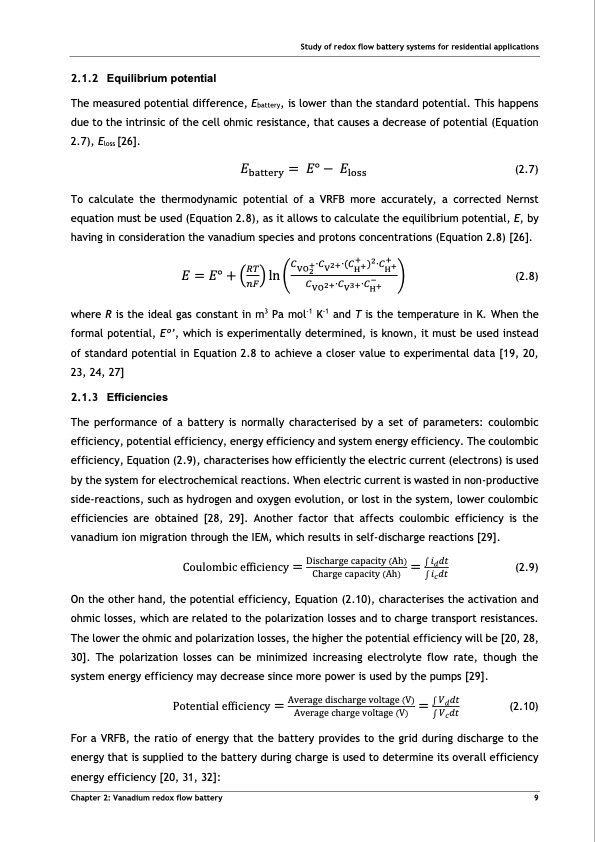
PDF Publication Title:
Text from PDF Page: 020
Study of redox flow battery systems for residential applications 2.1.2 Equilibrium potential The measured potential difference, Ebattery, is lower than the standard potential. This happens due to the intrinsic of the cell ohmic resistance, that causes a decrease of potential (Equation 2.7), Eloss [26]. 𝐸battery = 𝐸° − 𝐸loss (2.7) To calculate the thermodynamic potential of a VRFB more accurately, a corrected Nernst equation must be used (Equation 2.8), as it allows to calculate the equilibrium potential, E, by having in consideration the vanadium species and protons concentrations (Equation 2.8) [26]. where R is the ideal gas constant in m3 Pa mol-1 K-1 and T is the temperature in K. When the formal potential, Eo’, which is experimentally determined, is known, it must be used instead of standard potential in Equation 2.8 to achieve a closer value to experimental data [19, 20, 23, 24, 27] 2.1.3 Efficiencies The performance of a battery is normally characterised by a set of parameters: coulombic efficiency, potential efficiency, energy efficiency and system energy efficiency. The coulombic efficiency, Equation (2.9), characterises how efficiently the electric current (electrons) is used by the system for electrochemical reactions. When electric current is wasted in non-productive side-reactions, such as hydrogen and oxygen evolution, or lost in the system, lower coulombic efficiencies are obtained [28, 29]. Another factor that affects coulombic efficiency is the vanadium ion migration through the IEM, which results in self-discharge reactions [29]. Coulombic efficiency = Discharge capacity (Ah) = ∫ 𝑖𝑑𝑑𝑡 (2.9) Charge capacity (Ah) ∫ 𝑖𝑐𝑑𝑡 On the other hand, the potential efficiency, Equation (2.10), characterises the activation and ohmic losses, which are related to the polarization losses and to charge transport resistances. The lower the ohmic and polarization losses, the higher the potential efficiency will be [20, 28, 30]. The polarization losses can be minimized increasing electrolyte flow rate, though the system energy efficiency may decrease since more power is used by the pumps [29]. Potential efficiency = Average discharge voltage (V) = ∫ 𝑉𝑑𝑑𝑡 (2.10) Average charge voltage (V) ∫ 𝑉𝑐𝑑𝑡 For a VRFB, the ratio of energy that the battery provides to the grid during discharge to the energy that is supplied to the battery during charge is used to determine its overall efficiency energy efficiency [20, 31, 32]: Chapter 2: Vanadium redox flow battery 9 𝐶 +∙𝐶 2+∙(𝐶++)2∙𝐶++ 𝐸=𝐸°+(𝑅𝑇)ln(VO2 V H H ) (2.8) 𝑛𝐹 𝐶 2+∙𝐶 3+∙𝐶−+ VO V HPDF Image | Tubular Vanadium Air Redox‐flow battery

PDF Search Title:
Tubular Vanadium Air Redox‐flow batteryOriginal File Name Searched:
204521.pdfDIY PDF Search: Google It | Yahoo | Bing
Salgenx Redox Flow Battery Technology: Salt water flow battery technology with low cost and great energy density that can be used for power storage and thermal storage. Let us de-risk your production using our license. Our aqueous flow battery is less cost than Tesla Megapack and available faster. Redox flow battery. No membrane needed like with Vanadium, or Bromine. Salgenx flow battery
| CONTACT TEL: 608-238-6001 Email: greg@salgenx.com | RSS | AMP |